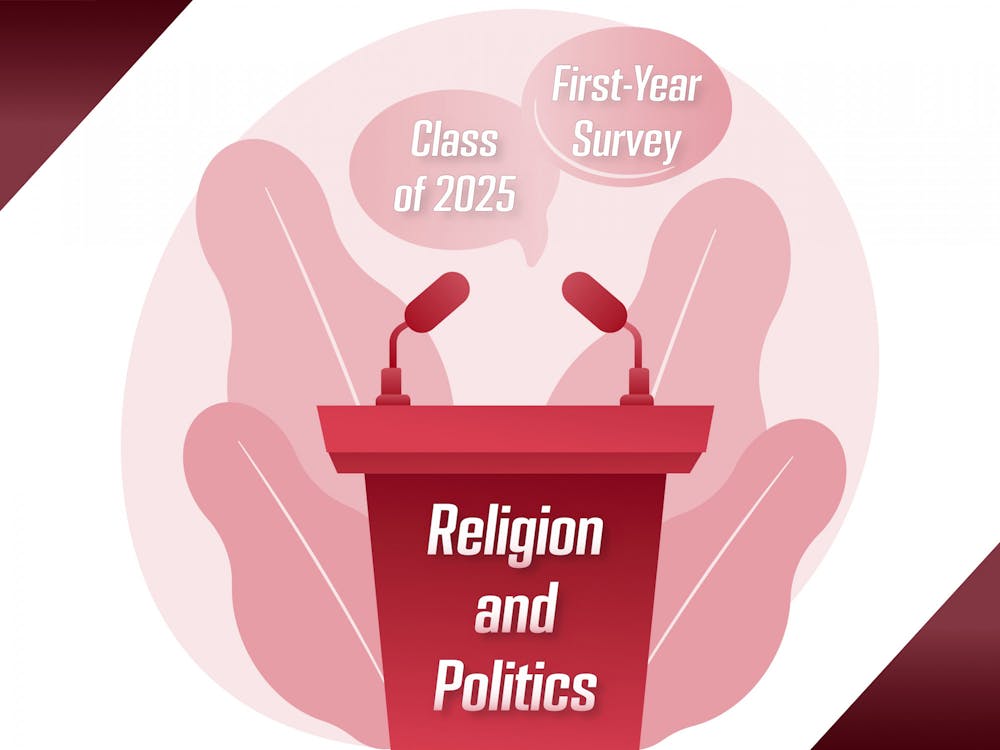Editor's note: This story is part of a series about the Class of 2025 based on a survey conducted by The Chronicle. You can read more about our methodology and limitations here, or see all of our survey coverage here.
We asked respondents in the Class of 2025 about their religious beliefs and political leanings. Then, we compared these aspects against their answers to other survey questions, from their interest in Greek life to views on Duke’s COVID-19 policies.
Of survey respondents, most first-years identified as liberal, with 40.7% as “somewhat liberal” and 32.3% as “very liberal.” Over 20% of students identified as “moderate,” 6.1% as “somewhat conservative” and 0.5% as “very conservative.”
A majority of first-years also indicated low levels of religiosity, with 68.7% responding as “not at all” or “not very” religious. As levels of religiosity increased, there were fewer first-years—17% identified as “somewhat religious,” followed by 11.5% “religious” and 2.8% “very religious.”
A closer look at religious views among first year respondents reveals that the largest group (24.1%) identify as atheists, followed by agnostic (23.5%). The largest percentage of people who do follow a religious denomination are Catholic (15.7%). Just under 12% of respondents are Jewish, 11.1% are Protestant and 0.4% are Muslim. One student selected “Buddhist” and 10.4% of respondents selected “other.”
Political Leanings
Political leanings and religiosity
The more first-years identify as liberal, the less religious they are
The more that first-years identify as liberal, the less religious they are, and vice versa. Nearly 40% of all “very liberal” first-years in our survey identify as “not at all religious” and just over 33% identify as “not very religious.”
A majority of “somewhat conservative” students indicated some religiosity, with 17.4% as “very religious” and 26.1% in both “somewhat religious” and “religious.” All “very conservative” students identified as “religious” or “very religious,” split evenly.
Among religious denominations, Muslim first-years were the most heavily liberal-leaning group, with 77.8% responding “somewhat” or “very” liberal, while Hindu respondents were the most moderate, with 36.8%.
Protestant, Catholic, and Jewish respondents had similar breakdowns in liberal and moderate beliefs, with 69.5%, 64%, and 70.3%, respectively, leaning liberal, 18.6%, 20%, and 24%, respectively, moderate. But while 5.4% of Jewish first-years reported “somewhat conservative” leanings, 12% of Protestant and 12% of Catholic respondents identified as “somewhat” or “very” conservative. Both were the only groups to have respondents indicate “very conservative” beliefs.
Note: The “Buddhist” category contains one student and was excluded from analysis.
Political leanings and race
Most racial groups identify as liberal-leaning
The majority of all racial groups identified as “very” or “somewhat” liberal—96.3% of Black or African American students, 81.3% of Hispanic or Latinx/e students and just under 72% of Asian students, white students and students who selected “A race/ethnicity not listed here.”
“Very conservative” students were only represented in the multiracial category, at 3%. Students who selected “A race/ethnicity not listed here” had the highest percentage (14.3%) of “somewhat conservative” students, followed by multiracial students.
Get The Chronicle straight to your inbox
Sign up for our weekly newsletter. Cancel at any time.
Note: The “Native American or Alaska Native” category contains one student and was excluded from analysis. The “A race/ethnicity not listed here” category contains seven students.
Political leanings and views on Duke’s COVID-19 policies
Conservative students more likely to report “strongly unfavorable” views of Duke’s COVID-19 policies
All students who identified as “very conservative” described their views of Duke’s COVID-19 policies as “strongly unfavorable.” About 43.5% of “somewhat conservative” students reported either “strongly unfavorable” or “somewhat unfavorable” views.
The trend generally holds vice versa—the more that students identified as liberal, the more they reported favorable views of Duke’s COVID-19 policies. Just under 58.5% of “somewhat liberal” students and 62.3% of “very liberal” students reported either “favorable” or “strongly favorable” views.
A slightly greater percentage of “somewhat conservative” students reported either “favorable” or “strongly favorable” views compared to “moderate” students—47.8% versus 45.5%, respectively.
Political leanings and Greek life
Most first-years who are not interested in Greek life are liberal leaning
First-years who were “somewhat liberal” and “very liberal” reported similar levels of interest and disinterest in Greek life at Duke. 50% of those who were “extremely interested” and 60% of “very interested” respondents identified as liberal. At the same time, a majority of “not interested at all” students are liberal (75.6%).
Similar levels of first-years in our survey across political leanings reported being “extremely interested” in Greek life at Duke, with 27.8% being “very liberal” students, 22.2% “somewhat liberal,” 27.8% “moderate,” and 22.2% “somewhat conservative.” On the other hand, a larger number of liberal first-years—40.3% “very liberal” and 35.4% “somewhat liberal”—reported no interest in joining Greek life.
Political leanings and family income
Over 95% of students with family incomes below $40,000 reported “moderate,” “somewhat liberal” or “very liberal” political beliefs. Similar percentages can be seen across income brackets up to $500,000. Among students who reported incomes above $500,000, this segment drops to 81.5%.
First-years who identified as “very conservative” consisted of 2.56% of first-years with family incomes between $40,000 and $80,000 and one percent of those between $125,000-$250,000. The largest percentage of first-years with conservative beliefs also had family incomes above $500,000, with 18.5% of these students identifying as “somewhat conservative.”
Note: The eleven students who did not report family incomes were excluded from analysis.
Political leanings and legacy status
Just under 71% of first-years who do not have a parent or sibling who attended Duke identify as “somewhat” or “very” liberal; for legacies, this jumps to 79.5%. Just over 6% in both legacy and non-legacy categories consist of “somewhat conservative” first-years.
Religiosity
Religiosity and race
Asian, white and multiracial first-year students had “not at all religious” plus “not very religious” majorities, with 69.1%, 64.9% and 62.7%, respectively.
Just under 86% of students who chose “a race/ethnicity not listed here” identify as “somewhat religious,” “religious” or “very religious.” These students were the most likely to be very religious, at 14.3%.
Over 44% of Black or African American first-years identify as “religious” or “very religious,” and 29.6% as “somewhat religious.” Nearly 38% of Hispanic or Latinx/e first-years identified as “religious” or “very religious,” and 18.8% as “somewhat religious.”
Note: The “Native American or Alaska Native” category contains one student and was excluded from analysis. The “A race/ethnicity not listed here” category contains seven students.

Milla Surjadi is a Trinity junior and a diversity, equity and inclusion coordinator of The Chronicle's 119th volume. She was previously editor-in-chief for Volume 118.

